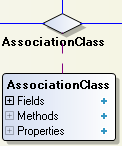UML 2.0 Class Diagram Elements
Go Up to UML 2.0 Class Diagrams
Contents
Model element is any component of your model that you can put on a diagram. Model elements include nodes and links between them.
Available Model Elements of UML 2.0 Class Diagrams
You can create model elements using the context menus in the Model and Diagram Views and using the Tool Palette.
The following table lists the available model elements of UML 2.0 class diagrams:
UML 2.0 class diagram elements
| Icon | Element | Name | Type | Comment |
|---|---|---|---|---|
|
Package |
Node |
|||
|
Class |
Node |
|||
|
Interface |
Node |
You can switch between these graphical representations using the View as Class property in the Object Inspector. | ||
|
Association Class |
Node |
An association class has both association and class properties and can be seen as an n-ary association that also has class properties. See N-ary Association in Relationships Among Elements of Class Diagrams. | ||
|
Enumeration |
Node |
|||
|
Data Type |
Node |
|||
|
Port |
A port is a property of a classifier (class or association class) that specifies a distinct interaction point between that classifier instance and its environment or between a classifier instance and instances it may contain. | |||
|
Instance Specification |
Node |
An instance specification specifies the existence of an entity that represents an instance of a model element in a modeled system and completely or partially describes the entity. | ||
|
Generalization |
Link |
Generalization and Implementation links are created by the same | ||
|
Provided Interface |
Link |
The set of interfaces realized by a classifier are its provided interfaces, which represent the obligations that instances of that classifier have to their clients. The provided interfaces describe the services that the instances of that classifier offer to their clients. | ||
|
Required Interface |
Link |
Required interfaces specify services that a classifier needs in order to perform its function and fulfill its own obligations to its clients. | ||
|
Association |
Link |
Possible types: association, aggregation, and composition. | ||
|
Association End |
Opens the Association End context menu to select the type (class, structure, enumeration, union) of a participant to add as an association end. |
Used to specify association end classes (participants) in an association, which property is represented by an Association Class. See N-ary Association in Relationships Among Elements of Class Diagrams. | ||
|
Dependency |
Link |
See the description of Dependency relationships in Relationships Among Elements of Class Diagrams. | ||
|
Node by Pattern |
Node |
Opens Pattern Wizard. | ||
|
Link by Pattern |
Link |
Opens Pattern Wizard. | ||
|
Constraint |
"OCL expression" or "free-syntax constraint" |
By default, the Modeling tries to validate the specified constraint text as an OCL expression. If it cannot be validated, then the Constraint is red highlighted. To suppress red highlighting, set the Constraint language property to | ||
|
Constraint link |
Constraint link |
|||
|
Note |
Annotation |
|||
|
Note Link |
Annotation link |
You see the note connected by the note link with another modeling element. | ||
|
Image |
Illustration - frame of the image placeholder. |
The Tool Palette command puts on a diagram only the empty frame of the image placeholder. To render an image in this frame:
Here you see the Embarcadero image, rendered in the frame of the image placeholder. | ||
|
Image Link |
Illustration link |
You see the Embarcadero image connected by the image link with another modeling element. |
Container Elements. Members of Container Elements
On class diagrams, some types of elements (containers) can have internal members. Internal members can be created in container elements using the context menus of container elements in the Model View and in the Diagram View.
The table below lists the available container elements of UML 2.0 class diagrams along with the members that can be added into them.
Available container elements and members
| Container element | Members available |
|---|---|
|
Package |
Package |
|
Class |
Class |
|
Association Class |
Class |
|
Interface |
Attribute |
|
Data Type |
Attribute |
|
Enumeration |
Enumeration literal |
Classifiers. Inner classifiers
In general, those modeling elements that can have instances are called classifiers. Classifiers have structural features (attributes) and behavioral features (operations). In the Modeling, classifiers are the basic nodes of Class diagrams: classes, interfaces, and association classes. Some of them can include other classifiers, or inner classifiers.
The table below lists the container elements of class diagrams along with the inner classifiers that you can add into container elements.
Inner classifiers:
| Container element | Available inner classifiers |
|---|---|
|
Class |
Class |
|
Association Class |
Class |
|
Interface |










